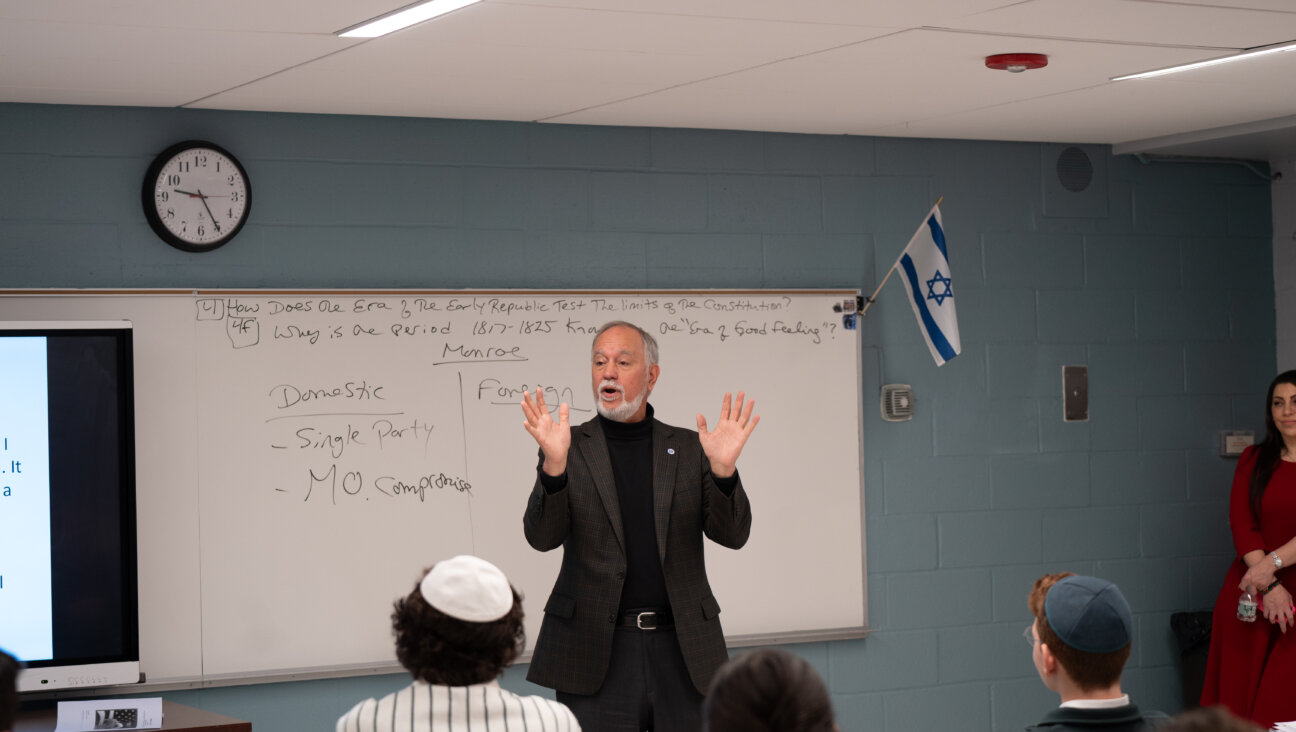How Jaffa’s Etzel House Stands At Odds With History

Graphic by Angelie Zaslavsky
On the border of Tel Aviv and Jaffa are the ruins of an old house overlooking the beach and the Mediterranean Sea, with an anomalous black cube rising from its remnants. This is the Etzel House, also known as the Museum of Jaffa’s Liberators. It is dedicated to fighters of the museum’s eponymous organization, better known as the Irgun in English, a Jewish militant group in Mandate Palestine led by Menachem Begin. Along with the nearby Hassan Bek mosque, the ruins are one of just two structures that remain from Manshiyya, formerly the northernmost neighborhood of Jaffa.
And there too are the figurative ruins, so to speak, of my former beliefs. I grew up an ardent supporter of Israel and was active in the Israel Action Committee at university. In 2013, I moved from New York to Israel to teach English on a MASA program—supposedly a twenty hour a week commitment, though MASA neglected to mention an almost equivalent time allotment tohasbara. I soon became disillusioned after frequent encounters with vitriolic racism and began questioning everything I knew, or thought I knew, about the country; among the early inquiries was Tel Aviv’s Bauhaus architecture, or rather: the lack of meaningful connections between its architecture and the Bauhaus, which led me further into city’s history and roots. After working in a school, I had a sense of what was happening in the school system—disparaging comments about co-existence from teachers, the general denigration of Arabic as an educational pursuit—but I was not totally prepared for what I found at the museum.
On this day of my visit, a school group has also come. Another class waits outside. A guide from the museum leads the students around the exhibits. She appears to be from an Orthodox nationalist background, doing national service as an alternative to the military. The students are from a secular school. They have come to learn about the war accompanying Israel’s establishment, particularly the battle for the city where they now stand.
The museum displays set the tenor for the tour. The Etzel, it conveys, was heroic, decisive, an unquestionable moral force for good. The Etzel tried to warn its fellow Jews (about the British, the UN partition plan, the Arabs) but was ignored: The Etzel was correct. The Etzel, whose emblem is a hand holding a rifle over the whole of Palestine and Transjordan, fought for your freedom, hesitantly forced into battle by the duplicitous (British, UN, Arabs).
“The Jewish homeland, like the homeland of every nation, is historically indivisible!” an Etzel poster on display reads, referring to the United Nations’ 1948 partition of British Mandate Palestine into what was to be two states—one Jewish, one Palestinian Arab. “Dividing the homeland into pieces is illegal. Compliance of the Jewish institutions with this illegal action is also illegal and does not obligate our people, who will continue to fight to liberate our entire homeland.”
The Arabs were indefatigable aggressors, the students learn. The Etzel tried to make peace with the Jews’ Arab brothers, in an effort to join forces against the British, but was rebuffed. Arab aggression flares up: The Etzel strikes back. They always fought with courage. Arabs mutilated corpses of the fallen. A movie tells the story of some particularly brave martyrs, killed by an Arab horde.
“The conquest of Jaffa was difficult because Etzel’s leadership was so moral,” the guide informs the students when they arrive to the museum’s main exhibit. Chaperones nod in agreement. The guide draws attention to Menachem Begin’s speech before the operation: “Be compassionate with women and children. Whenever someone lifts his hands in surrender, spare him. He is your prisoner, do not harm him.”
That mosque down the road? No one actually went to it, the guide tells the students, because the residents of this neighborhood drank alcohol; the residual implication: They were bad Muslims. But this idea draws some resistance from the students, who looked (and acted) like they were in middle school. “Muslims aren’t allowed to drink alcohol,” one boy protested. The guide conceded that not all Muslims were like this, only these ones were impious.
What happened to these residents? Jaffa, according to the museum, threatened to become “a naval and land base for Arab armies.” Etzel forces set out on April 25, 1948, “to remove the danger it represented to the city of Tel Aviv and its residents.” Etzel fighters start with Manshiyya (where the museum is located):
“After three days of hard fighting,” the museum display continues, “on April 28 the large Manshiyya [sic] quarter was taken with its mosque, Hassan Bek, which had cast a shadow of fear over Tel Aviv” (emphasis added). Jaffa is then finished by the “relentless bombarding” of Etzel mortars, causing “the mass flight of the Arab population.”
All of this account—both in the museum and from the guide— contradicts the well-documented historical facts.
Jaffa was under siege since the beginning of hostilities in November 1947, cut off from other Palestinian-Arab communities and surrounded by Jewish settlements on all sides. According to the historian Benny Morris, the Haganah, the pre-state predecessor to the Israeli army, determined that the city did not pose a threat to Tel Aviv. Jaffa’s leadership was conscious of the city’s precarious position and eager to avoid further escalation, fearful of the economic and social consequences. But in the view of Etzel’s leadership the city was, for the country’s Jewish community, a “cancer,” as it was described, according to Morris, in a meeting finalizing the decision to attack. This was especially so in the Etzel leaders’ view, because of its proximity to Tel Aviv, the militia’s power base.
Jaffa’s residents were further demoralized by a series of attacks specifically targeting civilians by the Etzel and the Lehi, or Stern Gang, another more extreme right-wing Zionist militia. These strikes were denounced at the time as rank acts of terrorism, just as Israel condemns such attacks today when committed by Palestinians. In one case, Etzel operatives dropped a barrel bomb from a vehicle on a busy avenue that rolled down the street and blew up outside of the Café Venezia in December 1947, killing six. In another, Lehi militants exploded a car bomb that destroyed Jaffa’s old town hall in January 1948, killing 28, mostly bystanders.
The city’s upper and middle classes began to flee, leaving behind an increasingly desperate situation as the city’s economy faltered.
Leading the Etzel’s operations against Jaffa was Amichai ‘Gidi’ Faglin, in whose memory the Etzel House is specifically dedicated. As Sharon Rotbard documents in White City Black City, a critical study of Tel Aviv’s history, Faglin employed a then novel tactic in the group’s campaign against Manshiyya. Etzel operatives created what were, in effect, overground tunnels within the neighborhood by blowing holes through the walls of contiguous houses on continuous city blocks, allowing Etzel fighters to move freely through the neighborhood under the protection of shelter.
The strategy effectively negated accepted notions of urban space—wall, house, street, inside, out—routing Manshiyya’s outflanked, outmanned defenders, and occasioning the neighborhood’s wholesale destruction. Images of Manshiyya after the war show the sort of wreckage and rubble we are accustomed to seeing in World War II-era Europe, or the Syria of today—accomplished without air power.
Manshiyya, however, was a geographic outlier, jutting into the heart of Tel Aviv. Jaffa required a different strategy. As the museum’s displays indicate, it was bombarded into submission. The Etzel fired approximately 20 tons of imprecise ordnance into Jaffa over the course of three days. There was nothing strategic, or innocent, or incidental, about the indiscriminate barrage of mortars that fell on the city, nor the collapse of order that followed.
In his pre-attack briefing, Faglin said the goal of the mortars was “to prevent constant military traffic in the city, to break the spirit of the enemy troops, [and] to cause chaos among the civilian population in order to create a mass flight.” The majority of casualties were, predictably, civilians. Some Jaffa residents were, literally, driven into the sea, with nowhere else to turn.
As one eyewitness, who related that he was “not yet fifteen,” when the bombardment rained down, recalled “I was overwhelmed by the sight of this huge mass of men, women, old people and children, struggling under the weight of suitcases or bundles, making their way painfully down to the wharfs of Jaffa in a sinister tumult. Cries mingled with moaning and sobs, all punctuated by deafening explosions.” Salah Khalaf, the memoirist who related this recollection, later grew up to become deputy chief of Fatah, the large mainstream faction of the Palestine Liberation Organization.
Some 40,000 residents of the city fled this bombardment, in addition to the 20,000 that had already left. More would flee by boat in the following days, until, along with the casualties, only 3,000 to 5,000 residents remained in Jaffa, out of a population of 70,000 to 80,000. Israel barred the vast majority from returning. Even some of those who stayed soon found themselves evicted by recent Jewish immigrants or soldiers seeking war spoils. As Morris recounts in The Birth of the Palestinian Refugee Problem Revisited, mass looting and vandalizing continued for weeks and the remaining Palestinian-Arab population was forcibly concentrated in the Ajami neighborhood. Jaffa was “liberated”—from its own residents and history.
The views of the Etzel, however, were not solely confined to a right-wing fringe. David Ben Gurion had been implacably hostile to Jaffa ever since he arrived at its port in 1906. He wrote in his diary in 1936, as quoted by Morris, “Jaffa’s destruction, the town and the port, will happen, and it is good that it will happen … This town, which fattened on Jewish immigration and settlement, deserves to be demolished [because] it swings an axe over the heads of its builders and feeders,” by which Ben Gurion meant the Jews of Tel Aviv (emphasis added). “If Jaffa goes to hell I will not participate in its grief,” Israel’s future founding prime minister wrote.
Yet to say that Tel Aviv rose out of the emptiness of the sand dunes, or some other variant of the immaculate conception story, is like saying that Long Island’s Nassau County was forged of some innate life force in the Harbor Hill moraine. If it wasn’t for Jaffa, and especially Jaffa’s port, there would have been no Tel Aviv. Its world-famous citrus industry provided an extant economic base and infrastructure. And it was cheap Arab labor from Jaffa and its environs, according to Rotbard and others, that built many of Tel Aviv’s buildings. Tel Aviv was originally founded as a suburb for Jewish workers in Jaffa.
But Israeli students are unlikely to learn about that Jaffa, its once flourishing culture or the fate of its residents. It is more likely that they will visit the Etzel House, which, with the consent of Israeli authorities, is helping to lay the foundation stones of History for a generation of Israeli students, few of whom will ever completely disinter its conceptual supports. According to attendance figures for 2010, over half of the visitors to the museum were school and military groups, about 10,000 students and soldiers in total.
While it is tempting to blame a rogue tour guide for this whole scene, she, too, is a recent product of the Israeli school system. The Etzel House may seem a small and isolated example, but in some regards it only tells crasser versions of stories long disseminated through Israeli textbooks.
One of the most contentious displays in the museum deals with Dayr Yassin. According to the museum, there was no massacre of more than 100 Palestinian-Arabs in April 1948 in the village of Dayr Yassin—and other than the defensive tone, there’s no hint of the generally accepted fact that it was Etzel fighters who were responsible. Rather, Dayr Yassin was a standard military operation, the fighters faced intense resistance, but overcame—fighting with great courage, presumably—and the operation was a turning point in the war, critical to securing Israel’s independence.
“According to the version which prevailed for many years, about 250 Arabs were killed [at Dayr Yassin],” the museum text reads. “This amazing number created panic among the Arab population and had an indirect effect on its flight from the country during the 1948 war.”
Students do not learn from the display that the village had previously negotiated and enforced a mutual non-belligerency pact with their Jewish neighbors, nor are they confronted with horrifying accounts of the massacre—that this “amazing number” was largely composed of women, children, and the elderly residents of the village.
Perhaps one shouldn’t expect an objective assessment from the EtzeI House, but Israeli textbooks express a similar justification, even if they don’t revel in the casualty count. According to the philologist Nurit Peled-Elhanan, while recent textbooks acknowledge the Dayr Yassin massacre to varying degrees, they all note that the resulting panic and mass flight was critical to securing the nascent state’s Jewish majority. One, The 20th Century: A History of the People of Israel in the Last Generations, concludes, “The escape of the Arabs solved a horrifying demographic problem.”
The Etzel and its activities generally receive positive treatment in these books. “Acts of terror and weapon-smuggling committed by Jewish underground forces and gangs such as the Haganah, the Irgun-Etzel and Lehi (the Stern Gang) against British occupation and against the Palestinian resistance to Zionism before the establishment of Israel,” Peled-Elhanan writes in Palestine in Israeli School Books, “are glorified within the discourse of Jewish emancipation and redemption, while the same acts committed by Palestinians against Israeli occupation are presented in criminal terms.”
It is an awkward fact that the Etzel (and the Lehi) helped pioneer the tactic of spectacular bombings in crowded public areas, such as, for example, a 1938 bomb in Jaffa’s vegetable market that killed 24 people. It was this same tactic that would later be turned on Israeli citizens. Etzel’s approach to violence, and especially the Dayr Yassin massacre, led Albert Einstein and Hannah Arendt, among others, to denounce the militia group as “a terrorist, right-wing, chauvinist organization” in an open letter to The New York Times.
These Israeli textbooks, for all the inconsistencies Peled-Elhanan cites, nonetheless represent an improvement over their predecessors. According to a study by Tel Aviv University education professor Daniel Bar-Tal, these earlier books largely depicted Arabs as primitive and backwards. More recent textbooks Peled-Elhanan found, incorporated more Palestinian viewpoints and even mentioned expulsions during 1948.
Lately, however, there has been a retrenchment. In 2009 the Likud party took control of the Ministry of Education with the election of Benjamin Netanyahu. The publisher of one textbook that presented the Palestinian view of 1948—that is, as the Nakba, or catastrophe—was ordered to change the offending section.
That civics textbook, Being Citizens in Israel: A Jewish Democratic State, was regarded as the one most amiable to Palestinian views and events. But the book was sanctioned for being too critical of the state, and especially for emphasizing discrimination against Palestinian citizens. The ministry, now controlled by Naftali Bennet, head of the far-right Jewish Home party, ordered a revision. Published last year, the revised text sparked an uproar among educators for emphasizing Jewish religious and sectarian, rather than civic, values. Some reports found that discussion of Muslim-Palestinian life in Israel had been minimized, largely reduced to a focus on discrimination against women.
In these textbooks and museum exhibitions are the germ of common Israeli attitudes: Israel is never the aggressor, but is the eternal victim of circumstance; the Israeli army is the most moral army in the world; the Palestinians don’t want peace; the Palestinians are to blame for whatever misfortune befalls them. And hovering over all of this, the Holocaust is an omnipresent reality that Israeli school children now must start learning about in kindergarten.
More frightening, perhaps, is what lessons they are inculcating as another “horrifying demographic problem”—a one-state solution—becomes increasingly likely, especially if Israel is to remain a Jewish democratic state. The Etzel House provides students and soldiers with one answer: the ends justify the means.
The presentations on display in this odd building in the no-man’s land between Tel Aviv and Jaffa constitute a small and isolated example perhaps; but it’s a presentation that’s also foundational to the current Israeli government’s worldview:
After the establishment of the state Begin founded a new political party, Herut, which he later merged with other right-wing parties in 1973 to form the Likud, the same party that Benjamin Netanyahu leads today.
Alex Cocotas is a writer living in Berlin. He previously lived in Israel and has written widely about the country’s history and culture.















